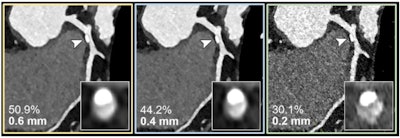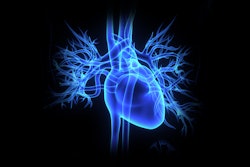Ultrahigh-spatial-resolution photon-counting detector CT (PCCT) improves the evaluation of coronary artery disease (CAD) -- enabling the reclassification of disease to a lower category in 54% of patients, researchers have found.
The technology could improve patient management and reduce unnecessary interventions, according to a team that included corresponding author Tilman Emrich, MD, of the Medical University of South Carolina in Charleston. The findings were published February 20 in Radiology.
"Our study provides a glimpse into the potential impact of performing coronary CT angiography [CCTA] using ultrahigh spatial resolution technology on risk reclassification and recommended downstream testing," he said in a statement released by the RSNA.
Coronary CT angiography (CCTA) is the go-to imaging test for assessing CAD, but its diagnostic value is limited in patients who have calcium buildup in the plaque of their coronary arteries, the group explained. Ultrahigh-spatial-resolution PCCT offers better image quality and spatial resolution than conventional CT, and thus shows promise for this particular indication.
Using ultrahigh-spatial-resolution PCCT, Tilman's group evaluated coronary stenoses in a vessel phantom that included two different stenosis grades (25% and 50%) and the PCCT findings from 114 people under evaluation for CAD. The team compared the phantom results to its manufacturer's specifications and interpreted patient results using the Coronary Artery Disease Reporting and Data System (CAD-RADS).
Not only did the investigators find that the PCCT phantom results showed a reduction in the overestimation of stenosis by mitigating the adverse effects of calcifications on the image, they found that the PCCT results from patients with suspected or diagnosed CAD showed a lower median degree of stenosis for calcified plaques compared with conventional CT images -- 29% versus 42%. In fact, of the 114 patients, 54% were given a lower CAD-RADS classification than originally assigned, the team reported.
 Coronary CT angiography for the suspected progression of known coronary artery disease in a 56-year-old female patient. Curved multiplanar reconstructions with 0.6-mm (yellow outline), 0.4-mm (blue outline), and 0.2-mm (green outline) section thickness show the respective calcified plaque (arrowheads) and coronary stenosis (inset images). The reduced section thickness leads to less calcium blooming and therefore a less severe assessment of percentage of coronary stenosis in this patient. Image and caption courtesy of the RSNA.
Coronary CT angiography for the suspected progression of known coronary artery disease in a 56-year-old female patient. Curved multiplanar reconstructions with 0.6-mm (yellow outline), 0.4-mm (blue outline), and 0.2-mm (green outline) section thickness show the respective calcified plaque (arrowheads) and coronary stenosis (inset images). The reduced section thickness leads to less calcium blooming and therefore a less severe assessment of percentage of coronary stenosis in this patient. Image and caption courtesy of the RSNA.
Ultrahigh-spatial-resolution PCCT could mitigate the limitations of conventional cardiac CCTA by reducing the overestimation of stenosis instigated by "calcium blooming," an effect that can cause calcifications to seem larger than they truly are.
"[Our findings] could significantly alter recommendations for downstream testing, potentially leading to a reduction of unnecessary procedures (and their potential complications) and reduced healthcare costs," Emrich said.
More research is in order, noted Cynthia McCollough, PhD, of the Mayo Clinic in Rochester, MN, in an accompanying editorial.
"Subsequent studies are needed to determine whether updated guidelines, with different threshold values for percentage [diameter stenosis] or CAD-RADS values, are needed for coronary CT angiography performed using [PCCT] to best treat patients with coronary artery disease," she wrote.
The complete study can be found here.




















